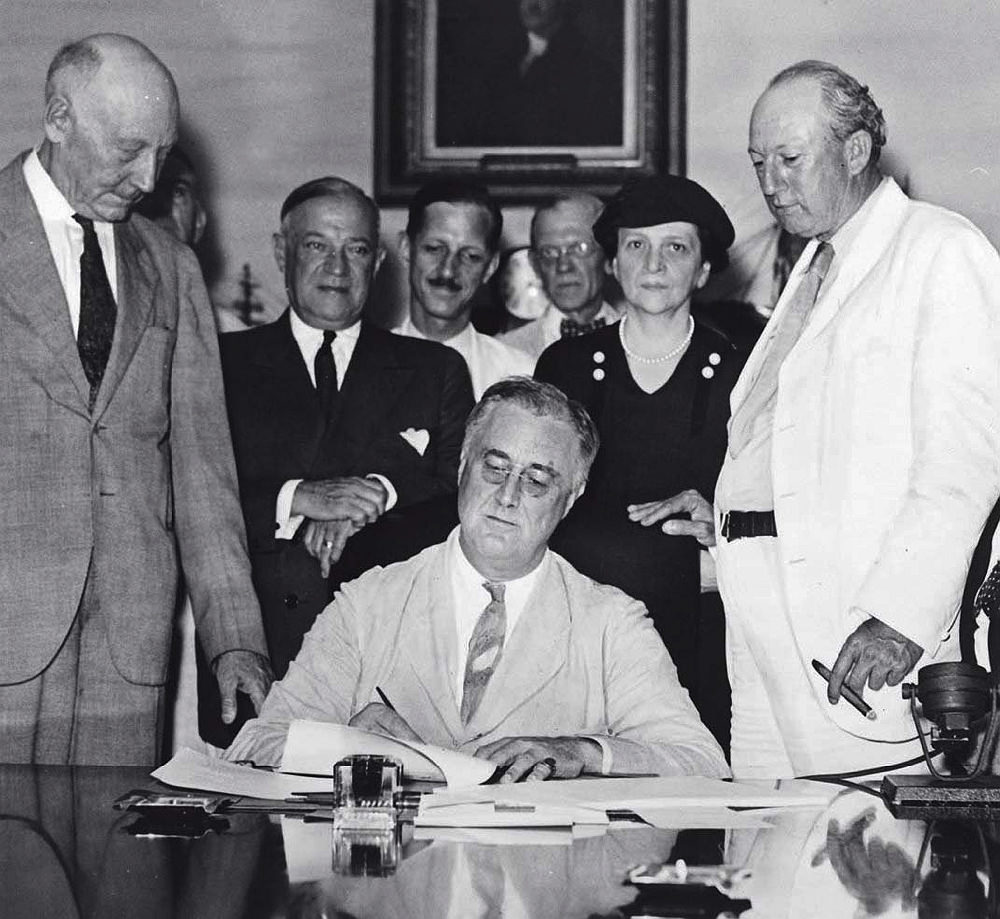Franklin D. Roosevelt, A.B. 1904, LL.D. ’29, opened his 1936 campaign for a second term as president by pressing to rebuild the United States as “a democracy of opportunity.” At the Democratic National Convention, FDR decried the way the nation’s oligarchs had “almost complete control over other people’s property, other people’s money, other people’s labor—other people’s lives.” The nation needed a new “economic constitutional order,” essential “to protect majorities against the enthronement of minorities,” through better education, training, work, housing, health care, and insurance.
As Joseph Fishkin and William E. Forbath ’74, explain in their visionary new book, “Roosevelt underscored that this kind of broad and wide-open middle class was not only essential to basic distributive fairness and economic freedom, it was also a necessary basis of political liberty and republican self-rule, and a necessary bulwark against oligarchy.” To Fishkin and Forbath, building a democracy of opportunity, which the nation should now aim to do again, requires addressing the needs of “all Americans in the economic and the political spheres.” The nation’s political economy—the interplay of political decisions and economic and financial relations, which shape the distribution of wealth and power that shapes politics—is the subject of their book. As they write, “It is an old way of thinking that is becoming new again. Before the twentieth-century rise of economics as a discipline, thinkers as varied as Adam Smith, John Stuart Mill, and Karl Marx understood economics and politics as inseparable.”
Crucially, they point out, American constitutionalism is fundamentally about economics and politics in the form of law. The book’s primary subject is the history and interpretation of the Constitution and what Fishkin and Forbath call “the democracy-of-opportunity tradition.” They argue persuasively that, from the founding of the American Republic to Roosevelt’s New Deal, “all sides” made arguments about how to interpret the Constitution to support their economic and political positions. That includes eighteenth-century leaders of the Democratic-Republican Party who sought “a more democratic and decentralized political economy,” nineteenth-century southerners who embraced slavery, and early-twentieth-century capitalists who favored laissez-faire policies, as well as FDR’s New Dealers. All “shared an understanding that the guarantees of the Constitution are inextricable from the structure of our economic and political life. They argued and fought about constitutional political economy.”
The Anti-Oligarchy Constitution rests on two major premises. First, that the American constitutional system is “headed for a historic confrontation” because the “slower-burning crisis of growing economic and political inequality” has concentrated too much power in too few hands. To deal with the crisis, a democracy of opportunity—carried out in economics, politics, and constitutional law—is the best form of society for the nation to create because it would serve the interests of all Americans. Second, that the right’s support for “rugged individualism, limited government, and private property” derives from laissez-faire constitutional politics born in the Gilded Age that began in the 1870s, and has evolved into a vigorous contemporary form of constitutional political economy, or “constitutional patriotism.” To counter this threat to the larger society, Fishkin and Forbath address what is “missing from our constitutional politics today”—“a comparably robust progressive account of what kind of community the Constitution promises to secure for all.”
They provide a progressive account that is cohesive, detailed, and inspiring. Reading it provides the pleasure and profit of understanding foundational American events and choices from an exhilarating vista: the panorama is fresh and brilliant and, most of all, hopeful. The account’s three “strands” are to pull back American democracy from becoming an oligarchy; to build and maintain a broad middle class as the foundation of a successful government and society; and to include as equal stakeholders people of all groups, whatever their race, ethnicity, gender, or nationality.
The core idea of the third strand, the authors write, “is to include, on equal terms, those who otherwise would have been excluded from the full range of opportunities the nation offers—in education, employment and occupations, housing, public accommodations, voting and politics, and everywhere that opportunities shape our lives.” Inclusion is a duty reflecting the Constitution’s commitment to equality. It is also “a structural condition for fair access to opportunity”—for producing “the mass middle class that is the social and economic base of republican government.” By “middle class,” they mean having enough income, savings, and insurance to feel comfortable and secure, and “to make a life with value in one’s own eyes.”
One imperative for rebuilding the middle class is reviving unions and other associations that “can give the many the means of challenging the political and economic dominance of the few.” Another is defining as criminal “mechanisms by which economic and political power are converted into one another,” like exchanges of financial contributions for government favors that aren’t explicitly bribes yet harm productive business, politics, and government. The danger is that, “because concentrations of economic and political power are mutually reinforcing, if they become sufficiently extreme, they threaten the Constitution’s democratic foundations.”

President Franklin D. Roosevelt, A.B. 1904, signs The Social Security Act, August 14, 1935—but politics and economics remain in constitutional contention.
Photograph from the Library of Congress
In contrast, the authors argue, their three strands—anti-oligarchy, a broad and open middle class, and inclusion—“are necessary to the most coherent version of the democracy-of-opportunity tradition and the only version that is compelling today.” Together, the strands can help make the future of the United States much brighter, by bringing the nation closer to its promise of providing all Americans with abundant life and liberty and the chance to seek sustained happiness. When the strands are pulled apart, the damage to American society is vast—a lesson of Donald Trump’s plutocratic populism. An oligarchy with too much economic and political power guts the middle class, stirs racial and ethnic resentment and thins out inclusion, and widens social and economic inequality.
The authors provide a progressive vocabulary for thinking about America’s history and future. But their work is not a polemic. It is a single-volume history of the United States, with a powerful, unfolding set of ideas about how and why Americans got where we are—and how we should move forward and why. The book has a gripping, must-read quality for anyone concerned about America today, resting on this indelible fact: “The American Constitution is the constitution of a republic, not an oligarchy.”
Fishkin and Forbath were longtime colleagues as professors at the University of Texas at Austin School of Law, with doctorates in politics and history, respectively, from Oxford and Yale, as well as Yale Law J.D.s. Fishkin is now a professor at UCLA School of Law. Forbath remains a professor at Texas Law School and is also associate dean for research there and a professor of history. (The authors acknowledge me in their book as a commenter on an earlier draft.) The book is a capstone for Forbath, a highly respected progressive constitutional scholar and legal historian. It is a confirmation of Fishkin’s talent as a rising star in the legal academy.
They began to work on the book in 2012. Their decade-long effort is apparent in the clarity, self-assuredness, and eloquence of their writing. The book is a model of the most convincing kind of argument, with meticulously supported explanation. Recounting and analyzing history, economics, politics, and law, their aim is to help spur the revival of a forgotten tradition by explaining its roots in America’s founding, its fruits in subsequent periods, and its critical potential today.
A key revelation is that central disputes in contemporary politics and law are based on faulty or incomplete premises. A primary example from constitutional history is that, when the Depression-era Supreme Court began to uphold New Deal laws, the Court and the legal and political culture reached a “settlement.” Under it, federal courts deferred to the economic and social legislation that Congress passed, but reserved to the courts zealous enforcement of rights. A famous footnote in a Supreme Court case elaborated on what the courts should scrutinize: violations of the Bill of Rights, failures of the political process, and protections of “discrete and insular minorities.”
For liberals, this settlement largely became gospel. Their respect for the Court that Chief Justice Earl Warren led from 1953 to ’69 and its landmark decisions granting racial equality, safeguarding voting rights, and improving criminal justice, among other momentous effects, redefined the institution for them as the supreme protector of individual rights and liberties. For conservatives, however, there was no settlement. “Opponents of New Deal economic policy,” write Fishkin and Forbath, “never gave up on the courts”— on having them strongly influence economic policy as well as personal rights and liberties.
The right turned Warren into a villain, and long after he was off the Court, attacked his name to rally support for conservative Republican candidates for president and the Senate. They succeeded at making the Court Republican, as it has been for the past half-century—largely dominated by Republican appointees, and led by three increasingly conservative, Republican-appointed chief justices. The Court is now so politicized that President Joseph Biden appointed a commission to consider reforms of the institution, including term limits and additional members.
The last time the nation seriously considered structural changes in the make-up of the Court was during the New Deal, before the one-sided settlement. To “save the Constitution from the Court and the Court from itself,” FDR said on the radio in a 1937 fireside chat, he proposed adding a new justice each time a sitting justice reached 70 and did not retire. Congress roundly rejected the so-called “court-packing plan,” which is now commonly viewed as a nakedly political, colossal failure.
But to the authors, the plan served FDR’s political-economy strategy: “Roosevelt’s overall political campaign against the Court, from the arguments in the 1936 campaign through the court-packing plan, was a success in the way that matters most: The Supreme Court did not strike down a single New Deal statute after 1937.” Fishkin and Forbath describe the current impetus for a possible progressive court-packing plan as a belated, “tit-for-tat response” to the Republican-controlled Senate’s 2016 refusal to confirm to the Court now-Attorney General Merrick B. Garland,’74, J.D. ’77, 10 months before the end of the Obama presidency.
The authors go on to note that “to convince a broad, reform-minded American public of the need for such dramatic measures, political leaders must offer arguments about constitutional substance, not just righting partisan wrongs.”
Rebuilding labor, which the authors advocate as a pillar of that substance and a countervailing power to oligarchy, is not merely a tactical move to realign white working-class men with the Democrats: it is a long overdue step toward fulfilling the guarantee of “economic security of the common man,” as the New Deal constitutional scholar Edward Corwin described it. Similarly, expanding efforts at racial and social inclusion, through provision of good education, health care, social insurance, and protection of voting rights, is not a matter of identity politics. Instead, it is a necessary step to help fulfill the promise of the Constitution’s Civil War amendments and redress centuries of racial subordination and inequality. Unraveling oligarchy by reforming antitrust, campaign finance, corporate governance, financial credit, and tax laws is not an attack on big business: it is essential to rebalance public and private interests, reduce concentrations of economic and political power, and, in the democracy-of-opportunity tradition, expand opportunity for all Americans.
“To reform our constitutional order to vindicate its underlying principles is no contradiction,” Fishkin and Forbath write. “The underlying principles remain what the Bible-quoting Abraham Lincoln called them: the ‘apple of gold,’ whereas the Constitution is a ‘picture of silver,’ subsequently framed around it.” Lincoln’s point, they emphasize, is this: “The Constitution is ‘made for’ those ideals, not the other way around.”









